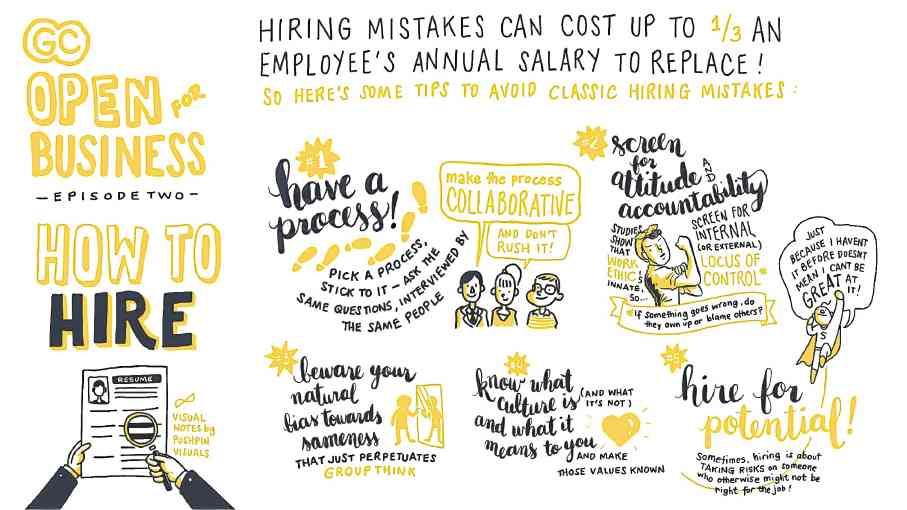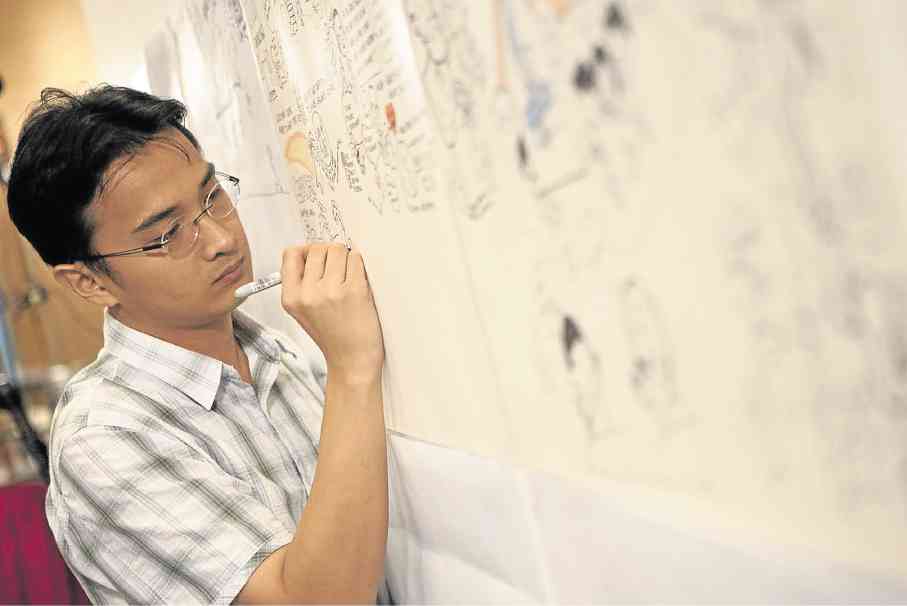Unloading their sleek smart phones and tablets on a table before them as they settle down for this interview, Elbert Or, Claudine Delfin, and Mayu Ferrer obviously can’t live without their high-tech devices. But that’s not to say the trio doesn’t appreciate the beauty that can result from using plain paper and pen.
Scribbling his name on a notebook, Or says, “Old school is the best school.”
That’s the message behind Pushpin, a visual solutions company founded in 2013 by Or, his wife Lorra Elena, and his former art students Delfin and Ferrer. Specializing in hand-drawn interpretations of ideas, concepts, processes, and conversations, Pushpin Visuals provides graphic summaries of lectures, meetings, seminars, brainstorming sessions, and other gatherings where audiences may not always remember everything a speaker says.
Or, who taught in his own art school before this venture, came up with Pushpin Visuals after noticing a huge, underserved market in visually compelling materials for communications and educational training. Eager as well to shift to more fulfilling work, he recruited Delfin and Ferrer when he discovered their similar drawing and note-taking styles.
“Inherently, everyone is visually oriented,” explains Or of the power of images over words, “We rely so much on what we see to process the world around us. I guess our educational system just focuses more on language and logic. But I think we’re naturally drawn to visuals, and it just so happens that media is moving in the same direction, where content has to be visually compelling.”
Visual facilitator
Standing on the sidelines of a gathering and armed with different color markers, a member of the Pushpin team (otherwise known as a visual facilitator) illustrates on the spot as a speaker talks, filling large mounted boards or sheets of paper with simple, cartoon-like illustrations and lettering of the talk’s key points.
After the event, the drawings are displayed in a common area of the venue where organizers and participants take pictures of them for future reference or post them on social media.
“People like the novelty of it. And when someone in the audience gets distracted and ends up watching us draw, at least his attention is still on the talk,” says Or.
Like the audience, the visual facilitators are hearing these talks for the first time; there is no pre-production meeting with a client or advanced copies of a speaker’s speech.
Or and his artists do get some background of the conference and its objectives—enough clues for them to do their own research and familiarize themselves with a specific subject matter and its jargon.
“Sometimes, knowing the title of the talk is a big help,” says Ferrer, “We also love it when titles suggest a list, like ‘5 ways to improve your social life,’ so we know beforehand how to space our illustrations on the board.”
“Actually, a lot of the work involves thinking and listening,” adds Or, “catching up with what the speaker is saying and processing it in our heads.”
Of the inevitable misspelled word or misinterpreted statement while drawing, visual facilitators simply cross an error with an X or write “oops,” which adds a lighthearted and human touch to the work.
“So much visual communication these days looks very polished and digital, they look detached and removed,” says Or, “We try not to make ours look ‘factory-produced.’ We’re going for that hand-made aesthetic that hopefully becomes more engaging.”
Regular clients
Not to mention effective. After three years of pilot-testing the technique with different companies and government agencies, Pushpin Visuals now boasts a stable of regular clients-Globe Telecommunications and Asian Development Bank, among others. They’ve illustrated talks on climate change, leadership, pharmaceuticals, and sustainable energy, and have even gone abroad to draw for regional clients. Of late, Or and Delfin provided the illustrations of Pinoy Manners: A Modern Guide to Delicadeza for All Generations by PR practitioner Joy Buensalido.
Anyone who’s witnessed the group at work will tell you that this kind of drawing isn’t child’s play. Visual facilitators can be on their feet for up to 10 hours drawing for whole-day conferences; imagine the strain on an artist’s arm and hand after the event. And while participants can pretend to listen as a speaker drones on and on, Or and his crew must always pay attention.
Still, it’s a job they wouldn’t trade for the world. Besides learning something new after each event (“We can now say ‘Asean skills mobility’ and know what it actually means!’ exclaims Or), the unique process lets these visual facilitators experience every artist’s dream. “Art is such a solitary process, so there’s an immediate gratification when we see audiences understand what a talk was all about through our drawings,” sums up Or, “There’s satisfaction in knowing that your work works.”
Visit www.pushpinvisuals.com.



